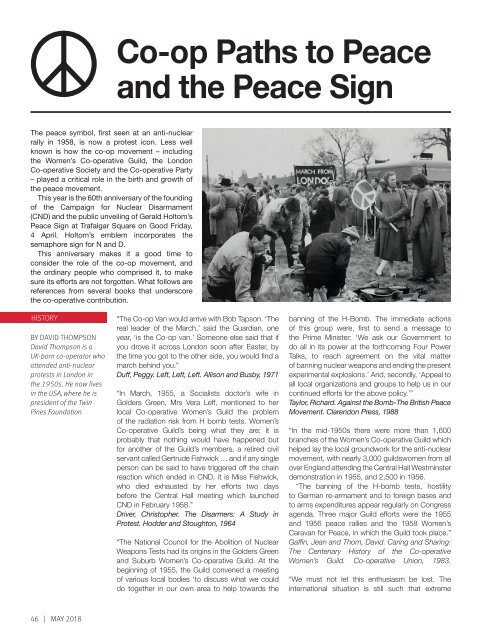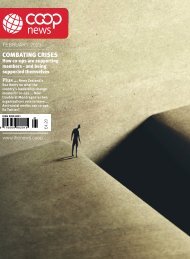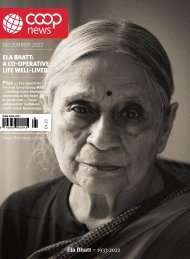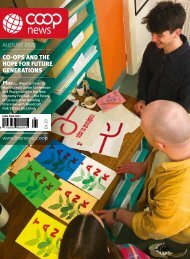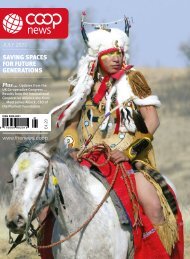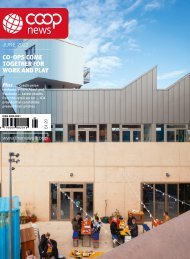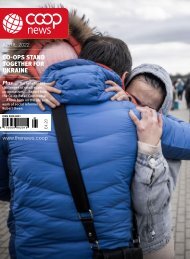MAY 2018
The May 2018 edition of Co-op News: connecting, challenging and championing the global co-operative movement. This issue shines a spotlight on governance – and how co-operatives do it differently. We also look at co-ops on the agenda in Westminster, sustainability supporting and preview some of the motions being put to the vote at the Co-op Group AGM.
The May 2018 edition of Co-op News: connecting, challenging and championing the global co-operative movement. This issue shines a spotlight on governance – and how co-operatives do it differently. We also look at co-ops on the agenda in Westminster, sustainability supporting and preview some of the motions being put to the vote at the Co-op Group AGM.
Create successful ePaper yourself
Turn your PDF publications into a flip-book with our unique Google optimized e-Paper software.
Co-op Paths to Peace<br />
and the Peace Sign<br />
The peace symbol, first seen at an anti-nuclear<br />
rally in 1958, is now a protest icon. Less well<br />
known is how the co-op movement – including<br />
the Women’s Co-operative Guild, the London<br />
Co-operative Society and the Co-operative Party<br />
– played a critical role in the birth and growth of<br />
the peace movement.<br />
This year is the 60th anniversary of the founding<br />
of the Campaign for Nuclear Disarmament<br />
(CND) and the public unveiling of Gerald Holtom’s<br />
Peace Sign at Trafalgar Square on Good Friday,<br />
4 April. Holtom’s emblem incorporates the<br />
semaphore sign for N and D.<br />
This anniversary makes it a good time to<br />
consider the role of the co-op movement, and<br />
the ordinary people who comprised it, to make<br />
sure its efforts are not forgotten. What follows are<br />
references from several books that underscore<br />
the co-operative contribution.<br />
HISTORY<br />
BY DAVID THOMPSON<br />
David Thompson is a<br />
UK-born co-operator who<br />
attended anti-nuclear<br />
protests in London in<br />
the 1950s. He now lives<br />
in the USA, where he is<br />
president of the Twin<br />
Pines Foundation<br />
“The Co-op Van would arrive with Bob Tapson. ‘The<br />
real leader of the March,’ said the Guardian, one<br />
year, ‘is the Co-op van.’ Someone else said that if<br />
you drove it across London soon after Easter, by<br />
the time you got to the other side, you would find a<br />
march behind you.”<br />
Duff, Peggy. Left, Left, Left. Allison and Busby, 1971<br />
“In March, 1955, a Socialists doctor’s wife in<br />
Golders Green, Mrs Vera Leff, mentioned to her<br />
local Co-operative Women’s Guild the problem<br />
of the radiation risk from H bomb tests. Women’s<br />
Co-operative Guild’s being what they are; it is<br />
probably that nothing would have happened but<br />
for another of the Guild’s members, a retired civil<br />
servant called Gertrude Fishwick … and if any single<br />
person can be said to have triggered off the chain<br />
reaction which ended in CND, it is Miss Fishwick,<br />
who died exhausted by her efforts two days<br />
before the Central Hall meeting which launched<br />
CND in February 1958.”<br />
Driver, Christopher. The Disarmers: A Study in<br />
Protest. Hodder and Stoughton, 1964<br />
“The National Council for the Abolition of Nuclear<br />
Weapons Tests had its origins in the Golders Green<br />
and Suburb Women’s Co-operative Guild. At the<br />
beginning of 1955, the Guild convened a meeting<br />
of various local bodies ‘to discuss what we could<br />
do together in our own area to help towards the<br />
banning of the H-Bomb. The immediate actions<br />
of this group were, first to send a message to<br />
the Prime Minister: ‘We ask our Government to<br />
do all in its power at the forthcoming Four Power<br />
Talks, to reach agreement on the vital matter<br />
of banning nuclear weapons and ending the present<br />
experimental explosions.’ And, secondly, ‘Appeal to<br />
all local organizations and groups to help us in our<br />
continued efforts for the above policy.’”<br />
Taylor, Richard. Against the Bomb-The British Peace<br />
Movement. Clarendon Press, 1988<br />
“In the mid-1950s there were more than 1,600<br />
branches of the Women’s Co-operative Guild which<br />
helped lay the local groundwork for the anti-nuclear<br />
movement, with nearly 3,000 guildswomen from all<br />
over England attending the Central Hall Westminster<br />
demonstration in 1955, and 2,500 in 1956.<br />
“The banning of the H-bomb tests, hostility<br />
to German re-armament and to foreign bases and<br />
to arms expenditures appear regularly on Congress<br />
agenda. Three major Guild efforts were the 1955<br />
and 1956 peace rallies and the 1958 Women’s<br />
Caravan for Peace, in which the Guild took place.”<br />
Gaffin, Jean and Thom, David. Caring and Sharing:<br />
The Centenary History of the Co-operative<br />
Women’s Guild. Co-operative Union, 1983.<br />
“We must not let this enthusiasm be lost. The<br />
international situation is still such that extreme<br />
46 | <strong>MAY</strong> <strong>2018</strong>


